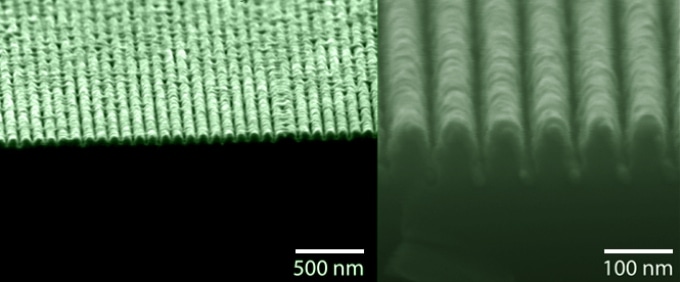Feb 17 2017
 SEM images of a "lossless" metamaterial that behaves simultaneously as a metal and a semiconductor. (Image credit: Ultrafast and Nanoscale Optics Group at UC San Diego)
SEM images of a "lossless" metamaterial that behaves simultaneously as a metal and a semiconductor. (Image credit: Ultrafast and Nanoscale Optics Group at UC San Diego)
A new material capable of reducing signal losses in photonic devices has been developed by engineers at the University of California San Diego. This advancement has the potential to increase the efficiency of a number of light-based technologies including lasers, fiber optic communication systems, and photovoltaics.
A huge challenge in the field of photonics has been reducing loss of optical (light-based) signals in devices called plasmonic metamaterials, which is addressed by this latest discovery.
Plasmonic metamaterials are materials designed at the nanoscale to manipulate light in unusual ways. They can be used to build interesting devices ranging from quantum computers to invisibility cloaks. But an issue with metamaterials is that they commonly contain metals which absorb energy from light and change it into heat. Therefore, a portion of the optical signal gets wasted, resulting in reduced efficiency.
In a latest study published in Nature Communications, a team of photonics researchers headed by electrical engineering professor Shaya Fainman at the UC San Diego Jacobs School of Engineering showed a method to compensate for these losses by incorporating a light emitting semiconductor into the metamaterial.
We’re offsetting the loss introduced by the metal with gain from the semiconductor. This combination theoretically could result in zero net absorption of the signal — a ‘lossless’ metamaterial.
Joseph Smalley, Electrical Engineering Postdoctoral Scholar, University of California San Diego
During their experiments, the researchers used an infrared laser to shine light onto the metamaterial. They discovered that based on which way the light is polarized - which direction (side to side, up and down) or plane all the light waves are set to vibrate - the metamaterial either emits or reflects light.
This is the first material that behaves simultaneously as a metal and a semiconductor. If light is polarized one way, the metamaterial reflects light like a metal, and when light is polarized the other way, the metamaterial absorbs and emits light of a different ‘color’ like a semiconductor.
Joseph Smalley, Electrical Engineering Postdoctoral Scholar, University of California San Diego
The new metamaterial was developed by the researchers by initially growing a crystal of the semiconductor material, known as indium gallium arsenide phosphide, on a substrate. Narrow trenches were then etched into the semiconductor using high-energy ions from plasma. This created 40-nm-wide rows of semiconductor spaced at a distance of 40 nm from each other. Finally, silver was used to fill the trenches in order to create a pattern of alternating nano-sized stripes of silver and semiconductor.
“This is a unique way to fabricate this kind of metamaterial,” Smalley said. Nanostructures with different layers are frequently created by depositing each layer individually one on top of another, “like a stack of papers on a desk,” Smalley explained. However, the semiconductor material ((indium gallium arsenide phosphide) used in this research cannot just be grown on top of any substrate (like silver), if not it will have deformities.
Rather than creating a stack of alternating layers, we figured out a way to arrange the materials side by side, like folders in a filing cabinet, keeping the semiconductor material defect-free.
Joseph Smalley, Electrical Engineering Postdoctoral Scholar, University of California San Diego
Going forward, the team plans to examine how much this metamaterial and other versions of it could enhance photonic applications that presently suffer from signal losses.